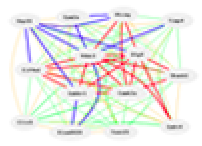

|

|

|
| | | | | | | | | | Welcome! Login |
Data Set Group2: EPFL/LISP BXD CD-HFD Heart Affy Mouse Gene 2.0 ST (Jan14) RMA
|
|
|
| Specifics of this Data Set: |
| None |
| Summary: |
| The BXD genetic reference population is a recombinant inbred panel descended from crosses between the C57BL/6 (B6) and DBA/2 (D2) strains of mice, which segregate for about 5 million sequence variants. Recently, some these variants have been established with effects on general metabolic phenotypes such as glucose response and bone strength. In this study, we examined both genetic variants across 40 strains of BXD and the two founder lines, in addition to a major environmental influence—long term feeding with chow diet (CD) or high fat diet (HFD)—to see how metabolic gene expression varies by genotype and environment, and gene-by-environment interactions. The basic heart phenotypes quantified in these cohorts were not affected by HFD feeding (e.g. blood pressure and heart rate). |
| About the cases used to generate this set of data: |
| 40 strains of the BXD family (BXD43 – BXD103) and both parental strains (C57BL/6 and DBA/2) were born and raised at the EPFL in Switzerland prior to inclusion in this study. For each strain, 10 male animals were born and then separated evenly into two cohorts at 8 weeks of age: 5 animals per strain on a chow diet (6% kcal/fat, 20% protein, 74% carbohydrate) and 5 animals per strain on high fat diet (60% kcal/fat, 20% protein, 20% carbohydrate). Animals adjusted to the diet for 8 weeks, and then an intensive phenotyping metabolic phenotyping protocol was followed from 16 to 24 weeks of age (respiration, cold tolerance, oral glucose response, VO2max exercise, voluntary exercise, basal activity). Animals were communally housed until the last 5 weeks of the experiment, allowing the animals to rest and reduce the direct expression effects of the phenotyping tests. Animals were fasted overnight prior to sacrifice, which occurred between 9am and 11am after isoflurane anesthesia and perfusion. Hearts were taken immediately after perfusion of the animal, weighed, and then frozen in liquid nitrogen no more than a minute after sacrifice. |
| About the tissue used to generate this set of data: |
| Hearts were later shattered in liquid nitrogen, usually broken into 2-4 pieces, and around half of the sample (at random) was taken for preparation. All ~5 animals per cohort had their RNA prepared, and then were pooled evenly (by µg of RNA) into a single RNA sample for each cohort, thus differences due to different segments of the heart being taken should be mitigated, although not eliminated, and researchers examining extremely specific transcriptional regulation in the heart should keep this in mind. The pooled RNA samples were then purified using RNEasy, then sent out for array analysis. All RIN values were > 8.0. |
| About the array platform: |
| All arrays were Affymetrix Mouse Gene 2.0 ST, prepared and run simultaneously in a single batch in January 2014 by Lorne Rose at the University of Tennessee Health Science Center. |
| About data values and data processing: |
| In general, the array data that we put in GeneNetwork has be logged and then z normalized, but instead of leaving the mean at 0 and the standard deviation of 1 unit, we shift up to a mean of 8 units and increase the spread by having an standard deviation of 2 units (what we call 2Z + 8 normalized data). This removes negative values from the tables. |
| Notes: |
| |
| Experiment Type: |
| All animals were communally housed by strain until phenotyping and fed a chow diet (CD; (Harlan 2018; 6% kCal/fat, 20% kCal/protein, 74% kCal/carbohydrate) throughout life after weaning until sacrifice at around 29 weeks of age, or a high fat diet (HFD; Harlan TD.06414 60% kcal/fat, 20% protein, 20% carbohydrate) after 8 weeks of age until sacrifice around 29 weeks of age. All BXD strains (BXD43–103) were originally sourced from the vivarium at the University of Tennessee Health Science Center (Memphis, TN, USA) then bred for two or more generations until progeny entered the phenotyping colony. C57BL/6J and DBA/2J were sourced from Janvier, which re-sources its “J” lines every 10 generations from The Jackson Laboratory. For tissue collection on CD and HFD BXD cohorts, animals were sacrificed under isoflurane anesthesia and cardiac perfusion after an overnight fast. High fat diet treatment and two day isolation for the recording experiment were considered as having low impact on the animals’ welfare, while all other measurements and conditions were considered as having no negative impact. All research was approved by the Swiss cantonal veterinary authorities of Vaud under licenses 2257.0 and 2257.1. |
| Contributor: |
| Williams EG, Andreux PA, Auwerx J, Lu L, Williams RW |
| Citation: |
| Please contact the laboratory of Rob Williams at the UTHSC |
| Data source acknowledgment: |
| The authors thank Cristina Cartoni, Sébastien Lamy, and Charles Thomas at the Center of Phenogenomics (CPG, EPFL) for help in establishing and phenotyping the BXD mice. We thank the Molecular Resource Center of Excellence at The University of Tennessee Health Science Center processing all microarrays. |
| Study Id: |
| 181 |

|
Web services initiated January, 1994 as Portable Dictionary of the Mouse Genome; June 15, 2001 as WebQTL; and Jan 5, 2005 as GeneNetwork. This site is currently operated by Rob Williams, Pjotr Prins, Zachary Sloan, Arthur Centeno. Design and code by Pjotr Prins, Zach Sloan, Arthur Centeno, Danny Arends, Christian Fischer, Sam Ockman, Lei Yan, Xiaodong Zhou, Christian Fernandez, Ning Liu, Rudi Alberts, Elissa Chesler, Sujoy Roy, Evan G. Williams, Alexander G. Williams, Kenneth Manly, Jintao Wang, and Robert W. Williams, colleagues. |

|

|
GeneNetwork support from:
|
|||
| It took 0.086 second(s) for tux01.uthsc.edu to generate this page | |||
